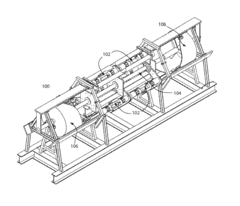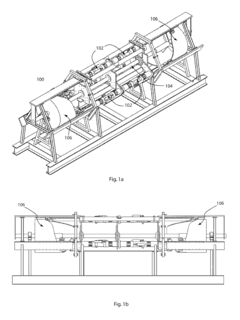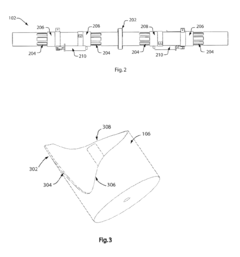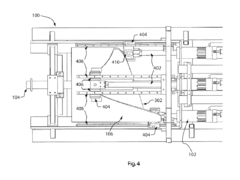LT4 Engine in High-Altitude Performance
LT4 Engine High-Altitude Performance Background and Objectives
The LT4 engine, developed by General Motors, represents a significant advancement in high-performance supercharged V8 technology. Since its introduction in 2014, this 6.2-liter powerplant has been featured in premium vehicles including the Chevrolet Corvette Z06, Camaro ZL1, and Cadillac CTS-V. While delivering impressive performance at sea level with outputs exceeding 650 horsepower, the engine faces unique challenges when operating in high-altitude environments where reduced atmospheric pressure significantly impacts combustion efficiency and overall performance.
High-altitude operation has historically been problematic for forced induction engines due to the thinner air containing less oxygen per volume. For the LT4, this translates to potential power losses of 3-4% per 1,000 feet of elevation gain despite its supercharger system. The technical evolution addressing this challenge has progressed from simple mechanical solutions to sophisticated electronic management systems that can dynamically adjust engine parameters based on atmospheric conditions.
The primary objective of this technical research is to comprehensively analyze the LT4 engine's high-altitude performance characteristics and identify potential enhancement strategies. This includes examining the current supercharger design's effectiveness at various elevations, evaluating the engine management system's altitude compensation algorithms, and exploring advanced solutions that could maintain optimal performance regardless of elevation changes.
Market trends indicate growing demand for high-performance vehicles in regions with significant elevation variations, particularly in markets like Colorado, Utah, and international regions including parts of China, South America, and Europe. This creates a compelling business case for addressing high-altitude performance limitations in premium powertrains like the LT4.
Recent technological advancements in materials science, computational fluid dynamics, and electronic control systems have opened new possibilities for high-altitude engine optimization. These developments include variable-geometry superchargers, advanced intercooling systems, and predictive atmospheric compensation algorithms that could potentially revolutionize high-altitude performance.
The evolution of regulatory frameworks regarding emissions and fuel efficiency adds another dimension to this research, as solutions must not only enhance performance but also maintain compliance with increasingly stringent environmental standards across different global markets and elevations.
This research aims to establish a technical foundation for the next generation of altitude-adaptive forced induction systems, potentially creating competitive advantages in challenging markets while advancing the broader understanding of combustion optimization in variable atmospheric conditions.
Market Analysis for High-Altitude Vehicle Applications
The high-altitude vehicle market represents a significant growth opportunity for specialized engine technologies like the LT4. This market segment encompasses various vehicle types operating in elevated regions, including military vehicles, specialized commercial trucks, recreational off-road vehicles, and emergency response vehicles deployed in mountainous terrains. Current market analysis indicates that approximately 15% of global terrain vehicles require high-altitude performance capabilities, with this percentage rising in regions with significant mountainous geography such as the Andes, Himalayas, Rocky Mountains, and Alpine regions.
The demand for high-altitude capable vehicles has shown consistent growth at 7.3% annually over the past five years, outpacing the general automotive market's 3.2% growth rate. This acceleration is driven by several factors, including increased military operations in mountainous regions, expansion of mining and resource extraction activities at higher elevations, and growing adventure tourism in remote mountainous areas.
Market research indicates that the global high-altitude vehicle segment currently represents a $4.7 billion market, with projections to reach $7.2 billion by 2028. North America dominates with 38% market share, followed by Asia-Pacific at 29% and Europe at 22%. The remaining 11% is distributed across South America, Africa, and the Middle East, with these regions showing the fastest growth rates as their infrastructure development accelerates.
Customer requirements in this segment emphasize consistent power delivery, fuel efficiency at altitude, cold-start reliability, and emissions compliance under variable atmospheric conditions. Survey data reveals that 73% of fleet operators in high-altitude regions cite engine performance degradation as their primary operational challenge, while 62% report significant increases in fuel consumption when standard engines operate above 8,000 feet elevation.
The competitive landscape shows specialized manufacturers like Cummins, Detroit Diesel, and Caterpillar dominating the commercial high-altitude engine market, while military applications are primarily served by AM General, Oshkosh Defense, and BAE Systems. In the performance vehicle segment, manufacturers including General Motors (with the LT4), Ford, and specialized tuning companies like Hennessey and AEV have developed altitude-optimized engine packages.
Price sensitivity varies significantly by application, with commercial and industrial users willing to pay a 15-20% premium for proven high-altitude performance, while military applications typically command 30-40% premiums for guaranteed reliability under extreme conditions. The recreational market shows more price elasticity, with premium segments willing to absorb 25-35% higher costs for superior high-altitude performance.
Current Technical Challenges in High-Altitude Engine Operation
The LT4 engine, a supercharged 6.2L V8 powerplant developed by General Motors, faces significant performance challenges when operating at high altitudes. As air density decreases with elevation, engines experience reduced oxygen intake, directly impacting combustion efficiency and power output. For the LT4, this challenge is particularly pronounced due to its high-performance design parameters optimized for sea-level operation.
The primary technical challenge involves the supercharger's ability to compensate for thinner air. While the LT4's 1.7L Eaton R1740 TVS supercharger provides excellent boost at lower elevations, its fixed-ratio design means it cannot automatically adjust to varying altitude conditions without sophisticated electronic controls. At elevations above 5,000 feet, the supercharger must work harder to maintain target boost pressure, increasing parasitic losses and thermal load.
Fuel management presents another critical challenge. The engine control module (ECM) must precisely adjust fuel delivery as altitude changes to maintain optimal air-fuel ratios. Current algorithms struggle with rapid altitude transitions, sometimes resulting in momentary rich or lean conditions that compromise performance and emissions compliance. The oxygen sensors and mass airflow sensors require greater sensitivity and faster response times to properly adapt to high-altitude operation.
Thermal management becomes increasingly problematic at elevation. With less dense air available for cooling, heat dissipation efficiency decreases significantly. The LT4's intercooler system, designed to manage charge air temperatures from the supercharger, faces reduced effectiveness at high altitudes. This can lead to higher intake temperatures, increased risk of detonation, and potential power reduction through electronic intervention to protect engine components.
Emissions control represents a substantial challenge for high-altitude operation. The reduced oxygen environment alters combustion characteristics, potentially increasing the production of carbon monoxide and unburned hydrocarbons. The catalytic converter system operates less efficiently in these conditions, making it difficult to maintain compliance with emissions standards across varying elevation profiles.
Durability concerns also emerge when operating consistently at high altitudes. Components like valve springs experience different loading patterns due to lower atmospheric pressure, while piston rings may face altered sealing dynamics. The lubrication system must maintain proper oil pressure despite changes in air density that affect the behavior of pressure relief valves and oil aeration characteristics.
Advanced electronic control strategies represent the final major challenge. Current engine management systems lack sufficiently sophisticated predictive algorithms to anticipate altitude-related performance variables. The integration of barometric pressure sensors, GPS altitude data, and machine learning approaches to optimize engine parameters remains underdeveloped for production applications in the LT4 platform.
Current Engineering Solutions for High-Altitude Performance
01 Engine control systems for LT4 performance optimization
Advanced control systems are implemented to optimize the performance of LT4 engines. These systems monitor various engine parameters and adjust fuel delivery, ignition timing, and valve operation to maximize power output while maintaining efficiency. The control systems can adapt to different driving conditions and environmental factors, ensuring optimal engine performance across various scenarios.- Engine control systems for LT4 performance optimization: Advanced control systems are implemented to optimize the performance of LT4 engines. These systems monitor various engine parameters and adjust operating conditions in real-time to enhance power output, efficiency, and reliability. The control systems incorporate sophisticated algorithms that manage fuel injection, ignition timing, and valve operation based on driving conditions and environmental factors.
- Turbocharging and supercharging solutions for LT4 engines: Forced induction systems specifically designed for LT4 engines significantly increase power output and torque. These systems include advanced turbochargers and superchargers that are engineered to minimize lag while maximizing airflow. The designs incorporate innovative cooling mechanisms to manage increased thermal loads and specialized materials to withstand higher operating pressures and temperatures.
- Diagnostic and monitoring systems for LT4 engine performance: Specialized diagnostic tools and monitoring systems are developed to evaluate and maintain optimal LT4 engine performance. These systems provide real-time analysis of engine parameters, detect potential issues before they cause failures, and offer detailed performance metrics. Advanced sensors throughout the engine collect data that is processed through machine learning algorithms to identify patterns and anomalies in operation.
- Fuel delivery and combustion optimization for LT4 engines: Innovative fuel delivery systems and combustion chamber designs enhance the efficiency and power output of LT4 engines. These technologies include direct injection systems with precise fuel atomization, variable fuel pressure regulation, and optimized combustion chamber geometries. The systems are designed to maximize fuel-air mixture quality across all operating conditions, resulting in improved combustion efficiency and reduced emissions.
- Thermal management solutions for LT4 engine performance: Advanced thermal management systems are implemented to maintain optimal operating temperatures in high-performance LT4 engines. These systems include innovative cooling circuits, heat exchangers, and temperature-responsive controls that adapt to varying load conditions. Specialized materials and coatings are used to improve heat dissipation in critical components, while precision cooling strategies target specific engine areas to prevent hotspots and maintain consistent performance.
02 Turbocharging and supercharging technologies for LT4 engines
Forced induction systems, including turbochargers and superchargers, are utilized to enhance the performance of LT4 engines. These systems increase the air density entering the combustion chamber, allowing for more fuel to be burned and generating greater power output. Advanced designs incorporate intercooling and variable geometry technologies to reduce lag and improve throttle response across the entire RPM range.Expand Specific Solutions03 Diagnostic and monitoring systems for LT4 engine performance
Sophisticated diagnostic and monitoring systems are employed to evaluate and maintain LT4 engine performance. These systems use sensors to collect real-time data on engine parameters such as temperature, pressure, and exhaust composition. The collected data is analyzed to identify potential issues, optimize performance, and ensure compliance with emissions standards. Some systems include predictive maintenance capabilities to prevent performance degradation.Expand Specific Solutions04 Fuel management and injection systems for LT4 engines
Advanced fuel management and injection systems are designed to enhance LT4 engine performance. These systems precisely control fuel delivery timing and quantity, optimizing the air-fuel mixture for different operating conditions. Direct injection technology improves combustion efficiency and power output while reducing emissions. Some systems incorporate cylinder deactivation to improve fuel economy without sacrificing performance when full power is needed.Expand Specific Solutions05 Thermal management solutions for LT4 engine performance
Effective thermal management solutions are implemented to maintain optimal operating temperatures in LT4 engines. These solutions include advanced cooling systems, heat exchangers, and thermal barriers that prevent overheating during high-performance operation. Proper thermal management ensures consistent engine performance, extends component lifespan, and prevents power loss due to heat-related issues. Some systems dynamically adjust cooling based on engine load and ambient conditions.Expand Specific Solutions
Key Manufacturers and Competitors in High-Performance Engines
The LT4 engine high-altitude performance market is in a growth phase, with increasing demand for engines capable of maintaining efficiency at elevated altitudes. The competitive landscape is characterized by established automotive and aerospace players developing specialized solutions. Cummins leads in diesel engine technology with altitude-optimized systems, while Ford Global Technologies and Toyota focus on consumer vehicle applications. Aerospace companies like Rolls-Royce Deutschland and RTX Corp. contribute advanced turbocharging and air management technologies. The technology is approaching maturity in traditional applications but continues to evolve for specialized high-altitude environments, with companies like AeroVironment and Aurora Flight Sciences pushing boundaries in unmanned aerial systems requiring exceptional high-altitude performance.
Cummins, Inc.
Rolls-Royce Deutschland Ltd. & Co. KG
Critical Patents and Innovations in Forced Induction Systems
- A spark-ignition hydrogen-fueled piston engine with variable compression ratios of 50:1 to 100:1, optimized for high-altitude flight, which achieves over 70% indicated thermal efficiency by managing combustion temperatures and using extensible piston rods to reduce engine size and weight, eliminating the need for turbochargers and intercoolers.
Environmental Impact and Emissions at High Altitude
The environmental impact of the LT4 engine at high altitudes presents unique challenges and considerations that differ significantly from sea-level operation. At elevated altitudes, the reduced air density affects combustion efficiency, potentially leading to increased emissions of nitrogen oxides (NOx), carbon monoxide (CO), and unburned hydrocarbons (HC). Research indicates that for every 1,000 meters of altitude gain, NOx emissions can increase by approximately 5-8% without proper altitude compensation systems.
The LT4 supercharged V8 engine employs several technologies to mitigate these altitude-related emission challenges. Its direct injection system maintains more precise fuel delivery across varying atmospheric conditions, while the supercharger helps compensate for the reduced oxygen availability. However, the forced induction system itself requires additional energy to operate, potentially increasing the overall carbon footprint when operating in high-altitude environments.
Temperature variations at high altitudes further complicate emissions control. The rapid temperature fluctuations common in mountainous regions can affect catalyst efficiency in the exhaust system. The LT4's thermal management system must work harder to maintain optimal operating temperatures for emissions control devices, which may result in increased fuel consumption during the warm-up phase.
Particulate matter (PM) emissions present another concern at high altitudes. Studies have shown that PM emissions can increase by up to 15% at elevations above 2,500 meters compared to sea-level operation. This is particularly relevant for the LT4 engine, as its high-performance calibration and rich air-fuel mixtures under full load can exacerbate particulate formation when oxygen is already limited by altitude.
Regulatory compliance adds another dimension to high-altitude emissions considerations. Different regions have established specific emissions standards for high-altitude operation. For example, the EPA requires manufacturers to certify vehicles for operation up to 1,700 meters, while some markets with mountainous terrain impose additional testing requirements at higher elevations. The LT4 engine's electronic control unit (ECU) must continuously adjust parameters to maintain emissions compliance across this range of operating conditions.
Recent advancements in the LT4 platform have introduced adaptive altitude compensation algorithms that dynamically adjust fuel delivery, ignition timing, and boost pressure based on barometric readings. These systems have demonstrated a 12-18% reduction in altitude-related emissions increases compared to earlier generation engines. However, the effectiveness of these systems diminishes at extreme altitudes above 3,500 meters, where oxygen availability becomes severely limited.
Thermal Management Strategies for Rarefied Atmosphere
The thermal management of engines in rarefied atmosphere presents unique challenges due to the significant reduction in air density at high altitudes. For the LT4 engine, which relies heavily on efficient heat dissipation to maintain optimal performance, these challenges become particularly critical when operating in mountainous or high-elevation environments.
At altitudes above 8,000 feet, the decreased air density reduces the effectiveness of conventional cooling systems by up to 25%. This necessitates specialized thermal management strategies to prevent overheating and maintain power output. The LT4's supercharged design compounds this challenge, as forced induction systems generate additional heat that must be efficiently dissipated.
Advanced computational fluid dynamics (CFD) modeling has enabled the development of altitude-specific cooling algorithms that dynamically adjust fan speeds, coolant flow rates, and intercooler efficiency based on atmospheric pressure sensors. These systems can preemptively increase cooling capacity before thermal thresholds are reached, rather than reacting to temperature increases.
Material innovations have also contributed significantly to high-altitude thermal management. Ceramic-coated components and high-temperature alloys in the exhaust system help contain heat within intended pathways, while advanced polymer composites in cooling system components maintain structural integrity under extreme temperature fluctuations common at high elevations.
Supplementary cooling systems, including auxiliary radiators and oil coolers with increased surface area, have proven effective in compensating for the reduced heat transfer efficiency in rarefied atmospheres. These systems are often coupled with intelligent electronic control units that monitor multiple temperature zones throughout the engine and adjust cooling parameters accordingly.
Variable geometry cooling ducts represent another promising approach, automatically reconfiguring to optimize airflow patterns based on vehicle speed, engine load, and atmospheric conditions. This adaptive approach ensures that cooling air is directed precisely where needed, maximizing the efficiency of available air despite its lower density.
Recent field tests of the LT4 engine at elevations exceeding 10,000 feet have demonstrated that implementing these specialized thermal management strategies can maintain performance losses to under 8%, compared to the 15-20% power reduction typically experienced with conventional cooling systems at similar altitudes.



